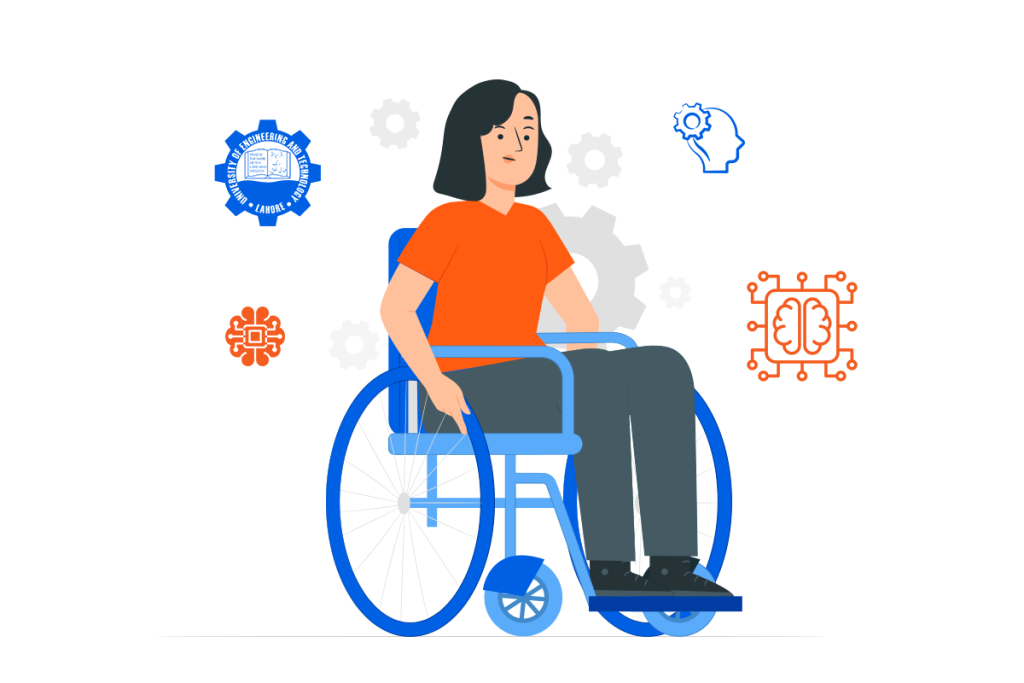Two students of the University of Engineering and Technology (UET) Mardan have created a prototype of an electroencephalogram based wheelchair for quadriplegic patients that can be controlled through the human brain. It is specially created for those patients who are physically paralyzed but have functional brains. In this research article, our Tashheer research team explains the invention of a Brain-Controlled Wheelchair for Quadriplegic Patients, developed by two UET students.
Read more about: A Guide to Getting Senior Citizen Card in Pakistan and its Benefits
Development Team and Supervision
Mohammad Faizan Akhtar and Mohammad Dawood, students of UET Mardan, developed the prototype of an EEG-based brain controlled wheelchair under the supervision of Dr Jawad Ali.
Technical Specifications of the Wheelchair
The model includes an electroencephalogram (EEG) headset and a battery-powered wheelchair that can carry a load of up to 250 kilograms for a human with powerful motors. The headset picks signals from the brain when the person thinks about moving in forward, backward, left, and right directions. These signals are transmitted to Arduino (microcontroller) to give commands to motors for moving according to a patient’s thinking. The wheelchair has a physical joystick besides a brain signal processing Bluetooth gadget for forward, backward, left, and right movement. Any brain wearing the electroencephalogram (EEG) headset can use it.

Control Mechanism
This is an Arduino-based wheelchair that is operated using the BCI technique of interpreting human brain waves. This approach is typical due to its low cost. Human brain wave signals can be received with an electroencephalogram (EEG) headset. Eye blinking is used to control the robot, as eye blinks normally trigger a large pulse in the EEG signal. The operator can direct the command to run the machine by blinking twice in a short time with a neural network being used to identify the blinking signal. By moving in different locations, the robot will test whether it can track the intended course, avoid obstacles, and stop in a particular location.
Impact and Benefits
Mohammad Dawood told Dawn News Reporter that wheelchairs are used by disabled people in daily life. Elders and partially disabled people mainly use wheelchairs because they face difficulties moving electric and mechanical wheelchairs. He also said they tried to overcome these difficulties of wheelchair users to a great extent. He added, “Our objective is to design a system that receives a signal from the person’s brain and moves accordingly. By the system, we mean the accumulator sensor. Its sensor converts the raw form of a signal into an electrical signal. The patient can control the wheelchair through diverse waves such as alpha, beta, gamma, delta, and theta, produced in the brain.” Mohammad Faizan Akhtar, the other student, said that the wheelchair would make patients’ lives easier. He said that the wheelchair could be used by any person with an active brain.
Challenges and Solutions
Developing a brain computer interface (BCI) system for wheelchair control has several challenges. One main hurdle is ensuring accurate and consistent signal recognition from a patient’s brainwaves. UET’s students who developed it likely addressed this by incorporating algorithms to filter out noise and improve signal interpretation. Additionally, extensive training for users to learn how to control the wheelchair with their thoughts might be necessary. Prof Imran Khan, Vice-Chancellor of UET Mardan, appreciated the efforts of their students. He added that such projects required very little effort to become a commercial product. He also claimed that their university administration was committed to providing maximum facilities to these students.
Future Prospects
This Brain-Controlled wheelchair will benefit the healthcare industry and the lives of disabled people in future. Some extra features can be added in the future to improve the practicality and functionality of the wheelchair. Obstacle detection using an ultrasonic sensor can be implemented. A patient health monitoring system can also be added to this wheelchair. If an emergency happens, a message will be sent to those responsible for the patient. Real-time Internet of Things (IoT)-based patient monitoring devices can also be integrated with the wheelchair to monitor the user’s physiological parameters such as heart rate, Spo2 level, ECG, and temperature. A feature to send Short Message Service (SMS) alerts can be added for guardians in case of wheelchair malfunctions like mechanical problems or accidents.





